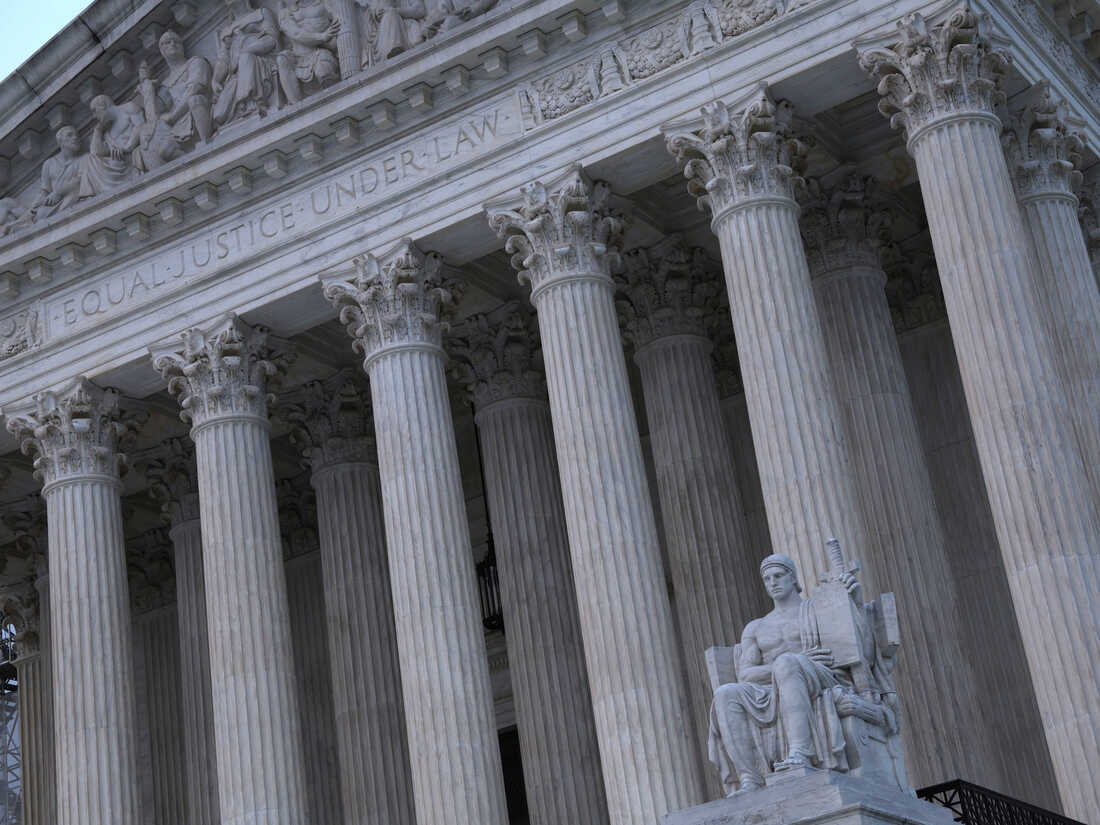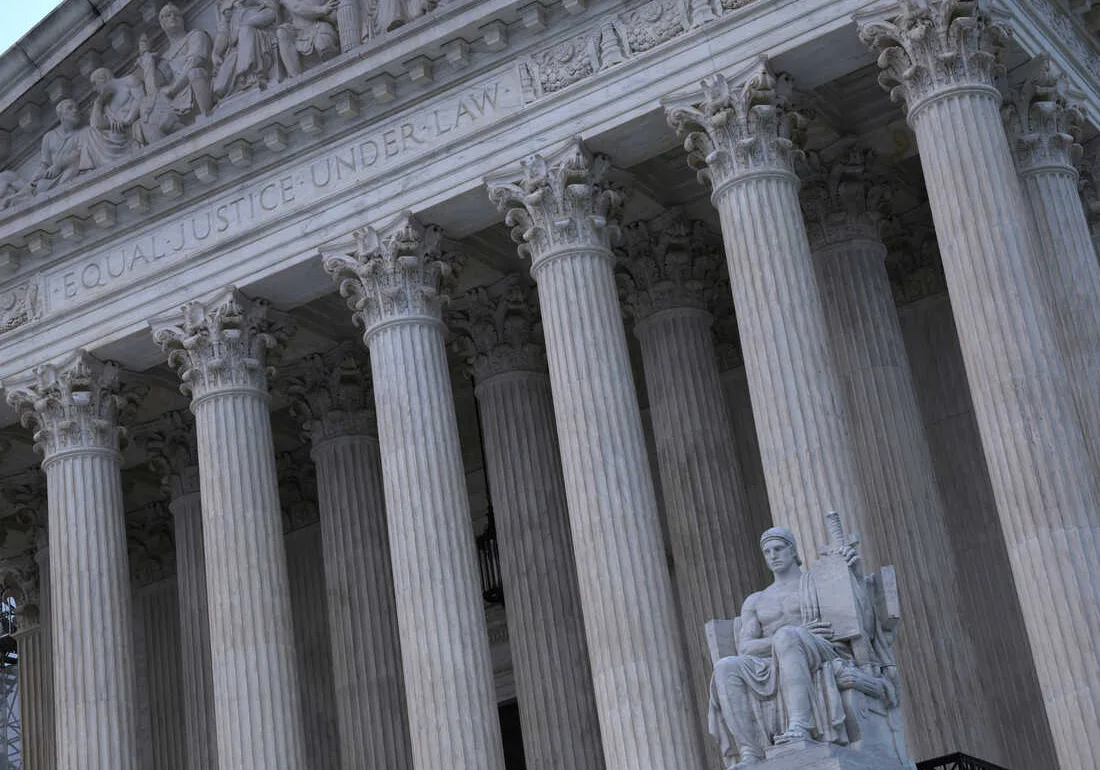
A view of the U.S. Supreme Court in Washington, D.C., on June 5.
Alex Wong/Getty Images
Alex Wong/Getty Images
U.S. Supreme Court dissents can be pointed, even acid on occasion. Justice Antonin Scalia once wrote in dissent that if he had written an opinion like the majority’s, he “would hide his head in a bag.”
But the next night he was dining with the author of the majority opinion, Anthony Kennedy, and other justices he disagreed with.
It’s hard to imagine that happening at today’s Supreme Court. Feelings seem raw, certainly for the court’s three liberal justices, who were on the losing end of some–but not all–of the court’s biggest cases this term. But just as upset from time to time are the conservatives, whose dissenting opinions, and even some concurring ones, betray long-held grievances.
And then there are the times that a dissent just gets under a justice’s skin. Take Justice Elena Kagan’s dissent on the last day of the court term, in which she protested Chief Justice Roberts’ opinion for the six-justice conservative super-majority, throwing out the Biden student loan forgiveness program.
Kagan pulled no punches. “In every respect, the Court today exceeds its proper limited role in our Nation’s governance,” she wrote. She noted that both the Trump and Biden administrations had taken steps to help student borrowers under a federal law that allows the Education Secretary, in a national emergency like the pandemic, to “waive or modify any statutory or regulatory provisions” applying to the federal student loan program.
“That may have been a good idea, or it may have been a bad idea. Either way, it was what Congress said,” she wrote. And yet, as Kagan and the other dissenters saw it, the majority’s opinion “from the first page to the last departs from the demands of judicial restraint,” using a “made-up” doctrine to jettison the [Education]Secretary’s loan forgiveness plan” thus overriding “the combined judgment of the Legislative and Executive branches.”
A dissent that stung?
The dissent, which Kagan underlined by announcing from the bench, must have stung, or perhaps it was just the last straw for the chief justice after a term in which he labored to bridge the court’s ideological divide and struggled to portray the court in public as apolitical.
“It has become a disturbing feature of some recent opinions to criticize the decisions with which they disagree as going beyond the proper role of the judiciary,” he wrote. “Reasonable minds may disagree…in fact at least three do. We do not mistake this plainly heartfelt disagreement for disparagement. It is important that the public not be misled either. Any such misperception would be harmful to this institution and our country.”
Kagan shot back that the strong words in her dissent “do not at all ‘disparage’ those who disagree. And there is surely nothing personal in the dispute here. But justices throughout history have raised the alarm when the court has overreached. … It would have been ‘disturbing’ and indeed damaging if they had not. The same is true in our own day.”
The exchange may have been remarkable, but it was respectful. That could not be said for Justice Clarence Thomas’ lengthy concurring opinion in the affirmative action case, lashing out at the court’s other African American justice, Ketanji Brown Jackson.
This was not a nasty footnote, like Scalia’s “head-in-a-bag” comment. It was a full-on, sustained attack on Jackson, by name, and her dissenting opinion in the University of North Carolina case. (She was recused from the Harvard case).
What’s more, the attack was personal in a tone, strikingly different from the tone he used when rebutting Justice Sonia Sotomayor’s dissenting opinion in the Harvard case.
Justice Thomas rails at Justice Jackson
For page after page, he railed against Jackson’s recitation of historical discrimination after the Civil War and well into the latter part of the 20th century, a view she bolstered with statistics showing enormous gaps for Blacks in inherited wealth, access to health care, and ability to buy even a modest home or build a small business because of bank practices that red-lined African Americans out of getting loans.
For six solid pages, he took aim at her dissent, contending that “on her view, almost all of life’s outcomes may be unhesitatingly based on race. “Such a view is irrational; it is an insult to individual achievement and cancerous to young minds seeking to push through barriers, rather than consign themselves to permanent victimhood,” he wrote.
“Make no mistake,” he added, Jackson’s dissent is “a call to empower privileged elites who will ‘tell us what is required to level the playing field’ among castes and classification that they alone can divine.”
“Her desire… to label all blacks as victims is unfathomable to me,” he continued. “History has taught us to abhor theories that call for elites to pick racial winners and losers in the name of sociological experimentation. … This vision of meeting social racism with government-imposed racism is thus self defeating. There is no reason to continue down this path.”
Jackson’s reaction
As he read excerpts from the opinion from the bench last week, Justice Jackson stared straight ahead, stone-faced.
And yet, her dissent makes only one reference to Thomas’s harsh words. In a long footnote. “Justice Thomas’s prolonged attack responds to a dissent I did not write in order to assail an admissions program that is not the one UNC has crafted,” she wrote, concluding that Thomas “ignites too many straw men to list or fully extinguish here.”
There is one final thing worth noting about the Thomas dissent. It was 58 pages long, far longer than Chief Justice Roberts’ 40-page majority opinion, which Thomas joined. And it was the first time in nearly 10 years that any justice has taken the exceedingly rare step of underlining a concurrence, not a dissent, by making an oral announcement from the bench. It was almost as if Thomas were saying he should have written the majority opinion, and this was his way of making that point.
They agree…but
Thomas was not the only member of the conservative super-majority to write a concurring opinion in the affirmative action case. Justice Neil Gorsuch wrote one, which Thomas also joined. It emphasized that the federal civil rights law says, as Gorsuch put it: “It is never permissable to say ‘yes’ to one person….but to say ‘no’ to another person, even in part, “because of the color of his skin.”
And Justice Brett Kavanaugh wrote a short concurrence as well, adding up to a total of 91 pages in concurring opinions in the case. Indeed, of those in the majority, only Justice Amy Coney Barrett and Samuel Alito didn’t write. Which tells you something about how difficult it is these days for a justice writing a majority opinion to keep five votes under one tent. Among the conservatives, there’s a lot of jostling for whose ideas are best.
Sotomayor’s dissent in gay rights-First Amendment clash
As for the dissents, there were lots of them in the last week of term and its serial thunderous opinions. Justice Sotomayor took the relatively rare step of reading hers from the bench in two 6-to-3 cases, the affirmative action decision in the Harvard case, and the decision carving out a major exception to public accommodations laws. The court’s conservatives said the exception was for speech protected by the First Amendment–in this case, expression by a web designer who didn’t want use her talents to create a wedding website for any same-sex couple because she is opposed to gay marriage on religious grounds.
Justice Sotomayor, in dissent, said the same exception could also apply to multiracial or Black couples who might be denied wedding services or other services from a vendor using the same argument. In the past, she noted, the court had rejected such arguments. “Today the Court, for the first time in its history, grants a business open to the public a constitutional right to refuse to serve” members of the public who are protected, by law, from discrimination based on race, gender, religion, or sexual orientation. “That is wrong. Profoundly wrong,” she said.
‘Where do the Navajo go from here?’
Justice Gorsuch, the court’s most outspoken advocate for Native Americans, wrote a particularly poignant dissent for himself and the court’s three liberals when the majority refused, by a 5-to-4 vote, to order the federal government to assess the the Navajo tribe’s water rights in the Colorado River under an 1868 treaty.
“Everyone agrees that the Navajo received enforceable rights by treaty,” he wrote. “Everyone agrees the United States holds some of those water rights in trust on the Tribe’s behalf. And everyone agrees the extent of those rights has never been assessed. Adding those pieces together, the Navajo have a simple ask: they want the United States to identify the water rights it holds for them.”
“Where do the Navajo go from here?” he asked. “To date, their efforts to find out what water rights the United States holds for them have produced an experience familiar to any American who has spent time at the Department of Motor Vehicles. The Navajo have waited patiently for someone, anyone, to help them, only to be told (repeatedly) that they have been standing in the wrong line and must try another.” But instead of making an accounting of the water, the government’s “constant refrain is that the Navajo can have all they ask for; they just need to go somewhere else first.”
Gorsuch did not announce his dissent from the bench. Instead, he stared into space forlornly as Justice Brett Kavanaugh read the majority opinion.
A shadow docket dissent in abortion pill case
Perhaps the oddest dissent of the term came in a “Shadow Docket” case, an emergency application from the Biden administration and Danco Laboratories, the leading maker of the abortion pill mifepristone, marketed as Mifeprex. They sought and obtained an order from the high court to block lower court decisions that banned or limited the FDA-approved use of the abortion pill while the case is litigated. The only noted dissents were from Justice Thomas, who wrote nothing, and Justice Alito, who did.
Alito, the author of last terms abortion decision, attacked the FDA, alleging that it had engaged in the practice of “leveraging” lower court decisions to make the drug more easily available during the pandemic, and he attacked the Biden administration, contending that it “has not dispelled legitimate doubts that it would even obey an unfavorable order in these cases.”
In fact, while some members of Congress made public statements urging the Biden administration to refuse to abide by the lower court decisions, the White House quickly rejected that idea. “It would set a dangerous precedent for this administration to disregard a binding decision,” said White House press secretary Karine Jean-Pierre four days before the emergency appeal went to the high court, and eleven days before Alito’s dissenting opinion.
The abortion pill case will almost certainly make its way back to the Supreme Court, and if past is prologue, there will be more fireworks then.



